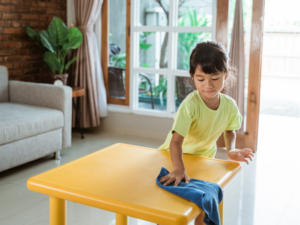Separation anxiety caused by going to school for the first time can be scary and overwhelming for children and parents. It can be difficult for children to leave the familiarity and comfort of home. It is natural to be anxious to leave their parents to go to a new and unfamiliar environment. This can cause children to experience separation anxiety, a feeling of distress or fear that occurs when separated from their primary caregiver.
Separation Anxiety is Normal
Generally, separation anxiety is a normal part of child development. These feelings can start as early as four months, intensify around 13-18 months, and continue until your child is 3-4 years old. It is often seen when a child is first starting school, daycare, or being left with a babysitter for the first time. This is because young children are still learning to regulate their emotions. They have not yet developed the coping skills to manage the stress of being away from their parents. Additionally, young children have not yet developed a sense of object permanence. They do not understand that things still exist even when they cannot see them.
Dealing With Separation Anxiety
When a child is experiencing separation anxiety, they may cry, cling to their parent, or refuse to go to school or daycare. This can be challenging for parents, who may feel guilty or worried about leaving their child in distress. However, it is important to remember that these are all normal reactions and that parents can do things to ease their child into situations. You can help them feel more comfortable and confident by taking a few simple steps.
Preparing for New Situations
| Do this! | How? | Why? | |
| Prepare your child for new situations | Talk about what to expect and what they can look forward to by reading a book together about starting school or daycare together. Visit the school/daycare ahead of time, show pictures of the new place or person they will be with, and meet the teachers/caregivers. | This can help your child feel more comfortable with the idea of going to a new place | |
| Troubleshooting | |||
| Issue | Solution | ||
| Not enough time to prepare your child. | Spend a few extra minutes with your child to walk them through the new situation in the moment, explain it to them, and allow them to get comfortable before leaving | ||
Establishing a Routine
| Do this! | How? | Why? | |
| Establish a goodbye routine | Have a special goodbye hug/kiss/handshake or even a silly saying or song you say/play before saying goodbye. Try role-playing (see example below!) they will be with, and meet the teachers and/or caregivers. | This can help your child feel more secure and know what to expect when it is time to say goodbye | |
| Troubleshooting | |||
| Issue | Solution | ||
| The goodbye routine is skipped. | Acknowledge the missed routine, reassure them that you still love them and value the routine, offer a routine the child can engage in independently or from a distance, and then follow up to see how they are feeling after missing the routine | ||
Remain Calm
| Do this! | How? | Why? | |
| Remain calm and positive when leaving your child | Try to be confident and reassuring by letting your child know that you trust the person who will be taking care of them and that you will be back soon | Children can easily pick up on their parent’s emotions so if you are feeling anxious or upset, it can make your child feel worse | |
| Troubleshooting | |||
| Issue | Solution | ||
| Life and emotions happen! | Acknowledge your own emotions to your child and model appropriate self-regulation strategies, like deep breathing | ||
Gradually Separate
| Do this! | How? | Why? | |
| Gradual separation | Start having short periods of time away from your child and gradually increase that time as they become more comfortable. For example, leave your child with a babysitter for 30 minutes while you practice self-care or go run errands and then gradually increase the time to an hour, and then two hours. | This helps children establish trust in you that you will come back and help them feel more secure with other caregivers. | |
| Troubleshooting | |||
| Issue | Solution | ||
| Childcare support to help with the gradual separation. | Enlist the help of family or friends to help and foster independence in other tasks (e.g., when the child asks for help, encourage them to try it first) | ||
Acknowledging Feelings
Also, remember to validate your child’s feelings and acknowledge that feeling scared or nervous is okay. Let your child know that you understand their feelings and that it’s normal to feel scared or sad when they are away from you.
Furthermore, you can also remind your child that you will be back. You can do this by saying, “I understand that you feel scared to leave me, and it’s okay to feel that way. Sometimes, we all feel a little nervous about new things or being away from people we love. But remember, you’ll have fun playing with your friends and learning new things at school. I will be back before you know it!” Validating your child’s feeling is an important step in dealing with separation anxiety.
Parental Separation Anxiety
Furthermore, this transition time can also be extremely difficult for parents. However, these strategies can help you to feel more comfortable and confident about your child starting a new stage. Separation anxiety away from your child is also normal, so don’t forget to take care of yourself!
- Seek Support: Talk to family and friends who have been through the same experience. Joining a parenting support group can also be beneficial!
- Practice Self-Care: As you practice gradual separation, spend that time doing something you enjoy! Go get coffee, exercise, read a book, watch a movie, or go for a walk.
- Build Trust with the Caregivers: Build trust by taking time to get to know your caregivers. Understand their style to help you feel more confident and comfortable leaving your child in their care.
Finally, separation anxiety can be overwhelming. However, actively dealing with it using the information above can help you and your child overcome those feelings.




